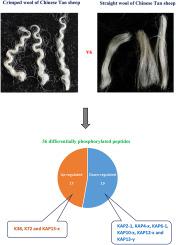Journal of Proteomics ( IF 3.3 ) Pub Date : 2021-01-15 , DOI: 10.1016/j.jprot.2021.104115 Dongqian He 1 , Liyao Chen 1 , Fang Luo 1 , Huitong Zhou 2 , Junkui Wang 1 , Qian Zhang 1 , Tongtong Lu 1 , Shaofei Wu 1 , Jon G H Hickford 2 , Jinzhong Tao 1

|
Proteins can be post-translationally modified and this can be important in the regulation of cellular processes and function. However, little is known about whether protein phosphorylation plays a role in regulating wool fibre properties. In this study, we used a chemical labelling method combined with a high performance liquid chromatography-mass spectrometry (HPLC-MS) analysis to compare the phosphopeptides present in the wool of three Tan sheep with highly crimped wool and three Tan sheep with straighter wool. Thirty-six phosphopeptides that had differences in relative abundance between these two types of wool were identified. These peptides were derived from 28 to 33 different proteins, including two keratins (Ks) and 7 to 12 keratin-associated proteins (KAPs), with these proteins being common structural components of the wool fibre. The crimped wool had a higher relative abundance of phosphorylated K38, K72 and KAP13-x, whereas the straighter wool had a higher relative abundance of phosphorylated KAP2-1, KAP6-1, KAP4-x, KAP10-x and KAP13-y. These results confirm the phosphorylation of wool Ks and KAPs, and suggest that differential phosphorylation of Ks and KAPs may affect wool fibre crimping in Tan sheep.
Significance
Protein phosphorylation can alter the structural conformation and interaction of a protein, and hence affect the cellular processes that the protein undertakes. In this study, we compared the suite of phosphorylated proteins in crimped and straight wool from Chinese Tan sheep and found that some keratins and keratin-associated proteins were phosphorylated. Crimped wool had more keratin phosphorylation, while straight wool had more keratin-associated protein phosphorylation, with this suggesting that wool fibre crimping may be a regulated by phosphorylation of some wool proteins. This suggests that wool traits may be under epigenetic control and that post-translation modifications need to be considered in breeding for different wool types.


























 京公网安备 11010802027423号
京公网安备 11010802027423号